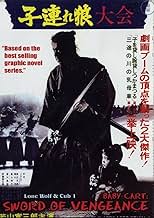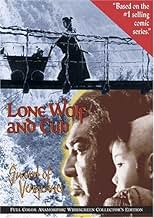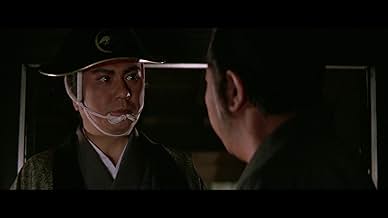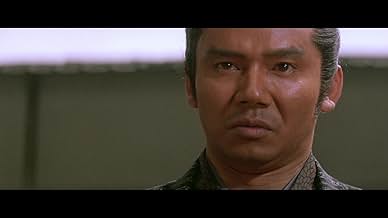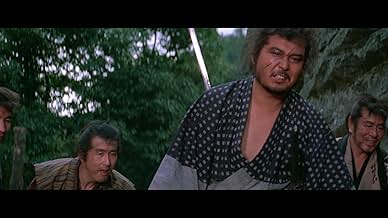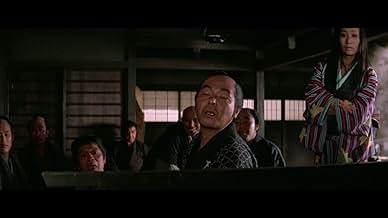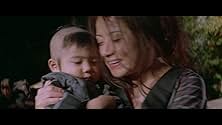Okami: Das Schwert der Rache
Originaltitel: Kozure Ôkami: Ko wo kashi ude kashi tsukamatsuru
IMDb-BEWERTUNG
7,7/10
9148
IHRE BEWERTUNG
Die Geschichte eines Ronin (d.h. eines herrenlosen Samurai), der mit seinem kleinen Kind durch die Landschaft Japans wandert und verschiedene Abenteuer erlebt.Die Geschichte eines Ronin (d.h. eines herrenlosen Samurai), der mit seinem kleinen Kind durch die Landschaft Japans wandert und verschiedene Abenteuer erlebt.Die Geschichte eines Ronin (d.h. eines herrenlosen Samurai), der mit seinem kleinen Kind durch die Landschaft Japans wandert und verschiedene Abenteuer erlebt.
Handlung
WUSSTEST DU SCHON:
- WissenswertesAkihiro Tomikawa, who portrays Ogami Itto's son, Daigoro, only ever played this one character for his on-screen acting career. He appears as Daigoro in all six 'Lone Wolf & Cub' feature films, and then in 1980's 'Shogun Assassin', which is recut footage from the first two films in the series.
- PatzerAfter disposing of the ronin on the village, Ogami collects Daigoro, places him the cart and leaves the village. He is not seen to re-assemble the hidden weaponry in the cart.
- Zitate
Ogami Itto: I am the Second designated by the Shogunate... Ogami Itto.
- Alternative VersionenThe 1999 UK video was cut by 6 secs by the BBFC to edit a scene where a woman is stripped topless, and the Artsmagic DVD featured the same print. The 2009 Eureka release (featured in the "Lone Wolf & Cub Collection") is fully uncut.
- VerbindungenEdited into Shogun Assassin (1980)
Ausgewählte Rezension
Kozure Okami:Kowokashi Undekashi Tsukamatsuru/Lone Wolf & Cub:Sword of Vengeance(1972) is the story of an once distinguished samurai executioner who was framed for treason. Shows how the main character went into being an avenging assassin. After the death of his wife, Ogami Itto makes a vow of vengeance on the people responsible for the murder of his wife and his frame up. With his son Daigoro by his side, Itto tends towards the road of assassin as a way to get even with his arch enemy, the Yagyu Clan. His assignment in this story is to kill a few high officers of a samurai clan who plan on killing their future leader.
The action sequences are visually arresting and physically awesome. The sword play in these action scenes are fresh and imaginative. Many of these scenes are gory and violent but not as gory as in some of the later Lone Film & Cub films. Lone Wolf & Cub:Sword of Vengeance(1972) does an excellent job in being faithful to the visual style of the samurai sword fights from the graphic novels. The camera work on these action scenes are free flowing with style and booming with graceful movement.
The film combines the back story of volume one and volume six in the Lone Wolf & Cub comics. The prologue and the first flashback is from volume six. The second flashback later in the movie is from the first volume. These scenes for the most part are faithful to the original source. The dialogue, however is slightly different in the film from volumes one and six.
The first flashback that depicts Itto's frame up by the Yagyu fills the screen with a sea of human emotions. This scene shows the relationship between Ogami and his wife to be caring and tender. The moment when Azami touches her son's face and then dies is very sad. One of the few times in the film and the series that Ogami Itto is highly emotional. Scene depicts Ogami Itto as a man who is bound by the code of Bushido.
Lone Wolf & Cub:Sword of Vengeance(1972) is not as polish or technically slick as the samurai films of Akira Kurosawa. Does not share Kurosawa's eye for the spectacle touch of his samurai pictures. Also, not deep in depiction of human nature and human error like Akira Kurosawa's Samurai epics. The mindset and the beliefs of the samurai is better depicted here. More an authentic look at the period of the Shogun and the fatalistic nature of the samurai warrior.
The scene where Ogami Itto gives his son the choice of the ball or the sword is intense and suspenseful. Its in this scene that Itto and his son Daigoro become the Lone Wolf & Cub. The choice given to Daigoro is cruel yet compassionate. When Daigoro touches the sword his path is more fatalistic and worst than death. A very emotional moment for Ogami Itto because of his love for his son and the fact that their path together will be of loneiness and tragedy.
The love scene with the prostitute and Ogami Itto is erotic yet not overly explicit. Effective in the use of camera movement and dissolves. Scene is well edited. The only love scene that Ogami Itto is involved during the entire Lone Wolf & Cub movies. Shows that Itto will sacrifice the feeling of shame to save a girl who is an outcast like himself.
The revenge motif dominates the motives of Ogami Itto as well as the plot development of Lone Wolf & CUb:Sword of Vengeance(1972). This motif is done in the same manner as in many Italian Westerns. The theme of revenge makes the film pretty much a Japanese Spaghetti Western. Honor and revenge are the two most important things for Ogami Itto. The motif of revenge is a strong force in both the comic and film version of Lone Wolf and Cub.
The Climatic battle scene builds up with an incredible amount of suspense. Awesome depiction of sword play with some gory moments. The camera moves around in a smooth fashion and acts as another member of the cast. The director, Kenji Misumi does the battle scenes in the graphic novel series. Tomisaburo Wakayama is excellent in doing this scene.
Contains a disturbing and harrowing rape scene. The cinematography, editing, and art direction are first class. Tomisaburo Wakayama was the perfect actor to play Ogami Itto because of his physical similarites. Akihiro Tomikawa is cute as Ogami Daigoro. The Violence here is on the level of the blood letting from The Streetfighter movies.
The action sequences are visually arresting and physically awesome. The sword play in these action scenes are fresh and imaginative. Many of these scenes are gory and violent but not as gory as in some of the later Lone Film & Cub films. Lone Wolf & Cub:Sword of Vengeance(1972) does an excellent job in being faithful to the visual style of the samurai sword fights from the graphic novels. The camera work on these action scenes are free flowing with style and booming with graceful movement.
The film combines the back story of volume one and volume six in the Lone Wolf & Cub comics. The prologue and the first flashback is from volume six. The second flashback later in the movie is from the first volume. These scenes for the most part are faithful to the original source. The dialogue, however is slightly different in the film from volumes one and six.
The first flashback that depicts Itto's frame up by the Yagyu fills the screen with a sea of human emotions. This scene shows the relationship between Ogami and his wife to be caring and tender. The moment when Azami touches her son's face and then dies is very sad. One of the few times in the film and the series that Ogami Itto is highly emotional. Scene depicts Ogami Itto as a man who is bound by the code of Bushido.
Lone Wolf & Cub:Sword of Vengeance(1972) is not as polish or technically slick as the samurai films of Akira Kurosawa. Does not share Kurosawa's eye for the spectacle touch of his samurai pictures. Also, not deep in depiction of human nature and human error like Akira Kurosawa's Samurai epics. The mindset and the beliefs of the samurai is better depicted here. More an authentic look at the period of the Shogun and the fatalistic nature of the samurai warrior.
The scene where Ogami Itto gives his son the choice of the ball or the sword is intense and suspenseful. Its in this scene that Itto and his son Daigoro become the Lone Wolf & Cub. The choice given to Daigoro is cruel yet compassionate. When Daigoro touches the sword his path is more fatalistic and worst than death. A very emotional moment for Ogami Itto because of his love for his son and the fact that their path together will be of loneiness and tragedy.
The love scene with the prostitute and Ogami Itto is erotic yet not overly explicit. Effective in the use of camera movement and dissolves. Scene is well edited. The only love scene that Ogami Itto is involved during the entire Lone Wolf & Cub movies. Shows that Itto will sacrifice the feeling of shame to save a girl who is an outcast like himself.
The revenge motif dominates the motives of Ogami Itto as well as the plot development of Lone Wolf & CUb:Sword of Vengeance(1972). This motif is done in the same manner as in many Italian Westerns. The theme of revenge makes the film pretty much a Japanese Spaghetti Western. Honor and revenge are the two most important things for Ogami Itto. The motif of revenge is a strong force in both the comic and film version of Lone Wolf and Cub.
The Climatic battle scene builds up with an incredible amount of suspense. Awesome depiction of sword play with some gory moments. The camera moves around in a smooth fashion and acts as another member of the cast. The director, Kenji Misumi does the battle scenes in the graphic novel series. Tomisaburo Wakayama is excellent in doing this scene.
Contains a disturbing and harrowing rape scene. The cinematography, editing, and art direction are first class. Tomisaburo Wakayama was the perfect actor to play Ogami Itto because of his physical similarites. Akihiro Tomikawa is cute as Ogami Daigoro. The Violence here is on the level of the blood letting from The Streetfighter movies.
Top-Auswahl
Melde dich zum Bewerten an und greife auf die Watchlist für personalisierte Empfehlungen zu.
- How long is Lone Wolf and Cub: Sword of Vengeance?Powered by Alexa
Details
Zu dieser Seite beitragen
Bearbeitung vorschlagen oder fehlenden Inhalt hinzufügen

Oberste Lücke
By what name was Okami: Das Schwert der Rache (1972) officially released in India in English?
Antwort

